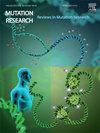USP7 accelerates colorectal cancer progression by up-regulating MYO6 through deubiquitination
IF 1.9
4区 医学
Q4 BIOTECHNOLOGY & APPLIED MICROBIOLOGY
Mutation Research-Fundamental and Molecular Mechanisms of Mutagenesis
Pub Date : 2025-05-17
DOI:10.1016/j.mrfmmm.2025.111908
引用次数: 0
Abstract
Background
Ubiquitin-specific protease 7 (USP7) is one of deubiquitinases and has been reported to regulate cancer cell biological processes through removing ubiquitin modifications from protein substrates. Myosins of class VI (MYO6) is shown to be highly expressed in many of cancers, and is associated with tumor progression in several cancers by affecting cell survival. Moreover, USP7 and MYO6 have been revealed to be involved in colorectal cancer (CRC) progression. Here, we aimed to investigate the intricate interplay between MYO6 and USP7 in CRC, and whether their interaction was associated with deubiquitination.
Methods
Quantitative real-time PCR and western blot were used to for mRNA and protein detection. Functional analyses were conducted using Cell Counting Kit-8, 5-ethynyl-2-deoxy-uridine, flow cytometry, wound healing and transwell assays in vitro, and murine xenograft models in vivo. M2 macrophage polarization was determined with CD206 antibody using flow cytometry. The protein interaction between MYO6 and USP7 was determined by chromatin immunoprecipitation assay. The deubiquitination effect of USP7 was validated by cellular ubiquitination and immunoprecipitation assay.
Results
CRC tissues and cells showed high expression of MYO6. Functionally, silencing of MYO6 suppressed CRC cell proliferation, migration, invasion, angiogenesis, induced cell apoptosis and negatively affected macrophage M2 polarization in vitro, and impeded CRC growth in vivo. For a mechanism analysis, USP7 could stabilize and up-regulate MYO6 expression by inducing MYO6 deubiquitination. USP7 was also highly expressed in CRC, USP7 silencing repressed CRC cell malignant phenotypes and reduced macrophage M2 polarization, while these effects were reversed by MYO6 overexpression.
Conclusion
MYO6 promoted CRC cell tumorigenesis and macrophage M2 polarization, and the mechanism was associated with USP7-induced MYO6 deubiquitination. These results suggested new targets for the development of epigenetic-based therapy in CRC.
USP7通过去泛素化上调MYO6,从而加速结直肠癌的进展
泛素特异性蛋白酶7 (USP7)是一种去泛素酶,据报道通过去除蛋白质底物上的泛素修饰来调节癌细胞的生物学过程。VI类肌球蛋白(MYO6)在许多癌症中高表达,并通过影响细胞存活与几种癌症的肿瘤进展相关。此外,USP7和MYO6已被发现参与结直肠癌(CRC)的进展。在这里,我们的目的是研究MYO6和USP7在CRC中复杂的相互作用,以及它们的相互作用是否与去泛素化有关。方法采用实时荧光定量PCR和western blot技术进行mRNA和蛋白的检测。使用细胞计数试剂盒- 8,5 -乙基-2-脱氧尿苷、流式细胞术、体外伤口愈合和transwell实验以及小鼠体内异种移植模型进行功能分析。用CD206抗体流式细胞术检测M2巨噬细胞极化。采用染色质免疫沉淀法测定MYO6与USP7之间的蛋白相互作用。通过细胞泛素化和免疫沉淀实验验证了USP7的去泛素化作用。结果scrc组织细胞MYO6高表达。在功能上,MYO6的沉默在体外抑制结直肠癌细胞的增殖、迁移、侵袭、血管生成,诱导细胞凋亡,并对巨噬细胞M2极化产生负面影响,在体内抑制结直肠癌的生长。机制分析表明,USP7可以通过诱导MYO6去泛素化来稳定和上调MYO6的表达。USP7在结直肠癌中也高表达,USP7沉默抑制结直肠癌细胞的恶性表型,减少巨噬细胞M2极化,而这些作用被MYO6过表达逆转。结论MYO6促进结直肠癌细胞的肿瘤发生和巨噬细胞M2极化,其机制与usp7诱导的MYO6去泛素化有关。这些结果为发展基于表观遗传学的结直肠癌治疗提供了新的靶点。
本文章由计算机程序翻译,如有差异,请以英文原文为准。
求助全文
约1分钟内获得全文
求助全文
来源期刊
CiteScore
4.90
自引率
0.00%
发文量
24
审稿时长
51 days
期刊介绍:
Mutation Research (MR) provides a platform for publishing all aspects of DNA mutations and epimutations, from basic evolutionary aspects to translational applications in genetic and epigenetic diagnostics and therapy. Mutations are defined as all possible alterations in DNA sequence and sequence organization, from point mutations to genome structural variation, chromosomal aberrations and aneuploidy. Epimutations are defined as alterations in the epigenome, i.e., changes in DNA methylation, histone modification and small regulatory RNAs.
MR publishes articles in the following areas:
Of special interest are basic mechanisms through which DNA damage and mutations impact development and differentiation, stem cell biology and cell fate in general, including various forms of cell death and cellular senescence.
The study of genome instability in human molecular epidemiology and in relation to complex phenotypes, such as human disease, is considered a growing area of importance.
Mechanisms of (epi)mutation induction, for example, during DNA repair, replication or recombination; novel methods of (epi)mutation detection, with a focus on ultra-high-throughput sequencing.
Landscape of somatic mutations and epimutations in cancer and aging.
Role of de novo mutations in human disease and aging; mutations in population genomics.
Interactions between mutations and epimutations.
The role of epimutations in chromatin structure and function.
Mitochondrial DNA mutations and their consequences in terms of human disease and aging.
Novel ways to generate mutations and epimutations in cell lines and animal models.

 求助内容:
求助内容: 应助结果提醒方式:
应助结果提醒方式:


